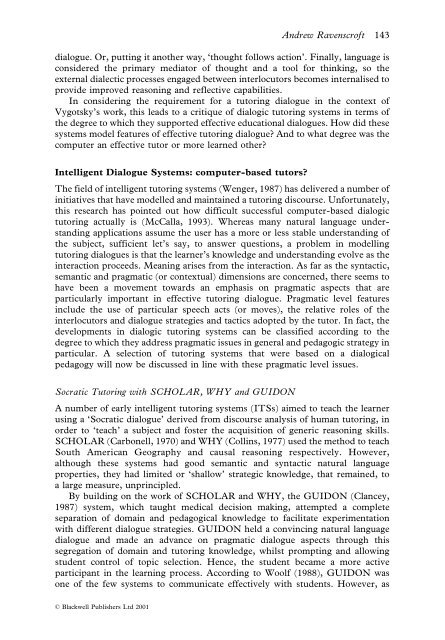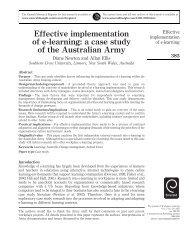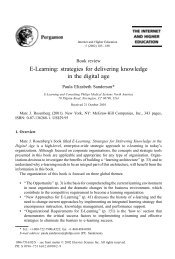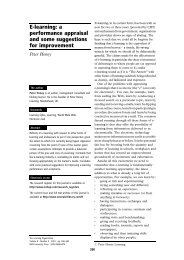Designing E-learning Interactions in the 21st Century: revisiting and ...
Designing E-learning Interactions in the 21st Century: revisiting and ...
Designing E-learning Interactions in the 21st Century: revisiting and ...
Create successful ePaper yourself
Turn your PDF publications into a flip-book with our unique Google optimized e-Paper software.
Andrew Ravenscroft 143<br />
dialogue. Or, putt<strong>in</strong>g it ano<strong>the</strong>r way, `thought follows action'. F<strong>in</strong>ally, language is<br />
considered <strong>the</strong> primary mediator of thought <strong>and</strong> a tool for th<strong>in</strong>k<strong>in</strong>g, so <strong>the</strong><br />
external dialectic processes engaged between <strong>in</strong>terlocutors becomes <strong>in</strong>ternalised to<br />
provide improved reason<strong>in</strong>g <strong>and</strong> reflective capabilities.<br />
In consider<strong>in</strong>g <strong>the</strong> requirement for a tutor<strong>in</strong>g dialogue <strong>in</strong> <strong>the</strong> context of<br />
Vygotsky's work, this leads to a critique of dialogic tutor<strong>in</strong>g systems <strong>in</strong> terms of<br />
<strong>the</strong> degree to which <strong>the</strong>y supported effective educational dialogues. How did <strong>the</strong>se<br />
systems model features of effective tutor<strong>in</strong>g dialogue? And to what degree was <strong>the</strong><br />
computer an effective tutor or more learned o<strong>the</strong>r?<br />
Intelligent Dialogue Systems: computer-based tutors?<br />
The field of <strong>in</strong>telligent tutor<strong>in</strong>g systems (Wenger, 1987) has delivered a number of<br />
<strong>in</strong>itiatives that have modelled <strong>and</strong> ma<strong>in</strong>ta<strong>in</strong>ed a tutor<strong>in</strong>g discourse. Unfortunately,<br />
this research has po<strong>in</strong>ted out how difficult successful computer-based dialogic<br />
tutor<strong>in</strong>g actually is (McCalla, 1993). Whereas many natural language underst<strong>and</strong><strong>in</strong>g<br />
applications assume <strong>the</strong> user has a more or less stable underst<strong>and</strong><strong>in</strong>g of<br />
<strong>the</strong> subject, sufficient let's say, to answer questions, a problem <strong>in</strong> modell<strong>in</strong>g<br />
tutor<strong>in</strong>g dialogues is that <strong>the</strong> learner's knowledge <strong>and</strong> underst<strong>and</strong><strong>in</strong>g evolve as <strong>the</strong><br />
<strong>in</strong>teraction proceeds. Mean<strong>in</strong>g arises from <strong>the</strong> <strong>in</strong>teraction. As far as <strong>the</strong> syntactic,<br />
semantic <strong>and</strong> pragmatic (or contextual) dimensions are concerned, <strong>the</strong>re seems to<br />
have been a movement towards an emphasis on pragmatic aspects that are<br />
particularly important <strong>in</strong> effective tutor<strong>in</strong>g dialogue. Pragmatic level features<br />
<strong>in</strong>clude <strong>the</strong> use of particular speech acts (or moves), <strong>the</strong> relative roles of <strong>the</strong><br />
<strong>in</strong>terlocutors <strong>and</strong> dialogue strategies <strong>and</strong> tactics adopted by <strong>the</strong> tutor. In fact, <strong>the</strong><br />
developments <strong>in</strong> dialogic tutor<strong>in</strong>g systems can be classified accord<strong>in</strong>g to <strong>the</strong><br />
degree to which <strong>the</strong>y address pragmatic issues <strong>in</strong> general <strong>and</strong> pedagogic strategy <strong>in</strong><br />
particular. A selection of tutor<strong>in</strong>g systems that were based on a dialogical<br />
pedagogy will now be discussed <strong>in</strong> l<strong>in</strong>e with <strong>the</strong>se pragmatic level issues.<br />
Socratic Tutor<strong>in</strong>g with SCHOLAR, WHY <strong>and</strong> GUIDON<br />
A number of early <strong>in</strong>telligent tutor<strong>in</strong>g systems (ITSs) aimed to teach <strong>the</strong> learner<br />
us<strong>in</strong>g a `Socratic dialogue' derived from discourse analysis of human tutor<strong>in</strong>g, <strong>in</strong><br />
order to `teach' a subject <strong>and</strong> foster <strong>the</strong> acquisition of generic reason<strong>in</strong>g skills.<br />
SCHOLAR (Carbonell, 1970) <strong>and</strong> WHY (Coll<strong>in</strong>s, 1977) used <strong>the</strong> method to teach<br />
South American Geography <strong>and</strong> causal reason<strong>in</strong>g respectively. However,<br />
although <strong>the</strong>se systems had good semantic <strong>and</strong> syntactic natural language<br />
properties, <strong>the</strong>y had limited or `shallow' strategic knowledge, that rema<strong>in</strong>ed, to<br />
a large measure, unpr<strong>in</strong>cipled.<br />
By build<strong>in</strong>g on <strong>the</strong> work of SCHOLAR <strong>and</strong> WHY, <strong>the</strong> GUIDON (Clancey,<br />
1987) system, which taught medical decision mak<strong>in</strong>g, attempted a complete<br />
separation of doma<strong>in</strong> <strong>and</strong> pedagogical knowledge to facilitate experimentation<br />
with different dialogue strategies. GUIDON held a conv<strong>in</strong>c<strong>in</strong>g natural language<br />
dialogue <strong>and</strong> made an advance on pragmatic dialogue aspects through this<br />
segregation of doma<strong>in</strong> <strong>and</strong> tutor<strong>in</strong>g knowledge, whilst prompt<strong>in</strong>g <strong>and</strong> allow<strong>in</strong>g<br />
student control of topic selection. Hence, <strong>the</strong> student became a more active<br />
participant <strong>in</strong> <strong>the</strong> <strong>learn<strong>in</strong>g</strong> process. Accord<strong>in</strong>g to Woolf (1988), GUIDON was<br />
one of <strong>the</strong> few systems to communicate effectively with students. However, as<br />
ß Blackwell Publishers Ltd 2001
















